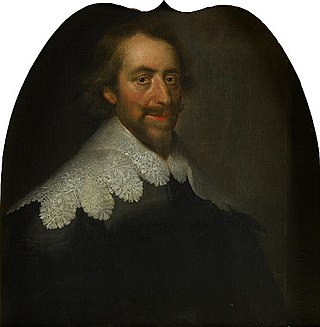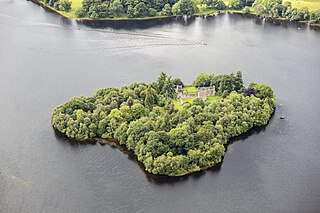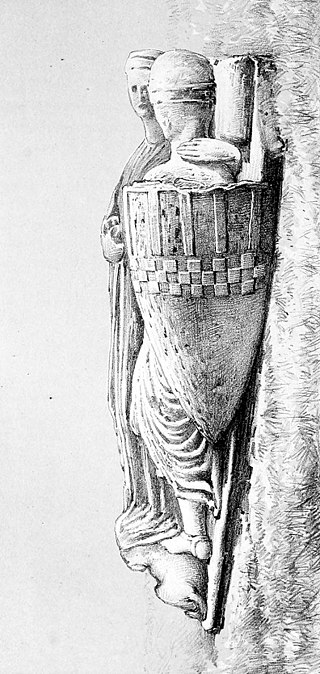
Menteith or Monteith, a district of south Perthshire, Scotland, roughly comprises the territory between the Teith and the Forth. Earlier forms of its name include Meneted, Maneteth and Meneteth.

Lake of Menteith, also known as Loch Inchmahome, is a loch in Scotland located on the Carse of Stirling.

Doune Castle is a medieval stronghold near the village of Doune, in the Stirling council area of central Scotland and the historic county of Perthshire. The castle is sited on a wooded bend where the Ardoch Burn flows into the River Teith. It lies 8 miles northwest of Stirling, where the Teith flows into the River Forth. Upstream, 8 miles further northwest, the town of Callander lies at the edge of the Trossachs, on the fringe of the Scottish Highlands.

William Graham, 7th Earl of Menteith, 1st Earl of Airth, was a 17th-century Scottish nobleman. A supporter of King Charles I, he held offices including Lord President of the Court of Session and was a Privy Counsellor. Although he fell from favour, he continued to support the Royal cause during the Wars of the Three Kingdoms, when his estates were damaged by the troops of Oliver Cromwell. He married Agnes, daughter of Patrick, Lord Gray, and had a son John Graham, Lord of Kinpont, who had a son William Graham, 8th Earl of Menteith who prior to his death was styled William Graham, Lord of Kinpont.

Inchmurrin is an island in Loch Lomond in Scotland. It is the largest fresh water island in the British Isles.

Lochranza Castle is an L-plan fortified tower house situated on a promontory in Lochranza, on the northern part of the Isle of Arran in Scotland. Most of the current structure was built in the 16th century.

Inchmahome Priory is situated on Inchmahome, the largest of three islands in the centre of the Lake of Menteith, close to Aberfoyle, Scotland.
Monteith or Menteith may refer to:

Loudoun Castle is a ruined country house nicknamed the "Windsor of Scotland" located near Galston, in the Loudoun area of Ayrshire, Scotland. The majority of the building was constructed from 1804 to 1811 around existing structures dating to the 15th and 17th centuries. The building was destroyed by fire in 1942 and never rebuilt, while the rest of the property was converted into the Loudoun Castle theme park in 1995 and closed in 2010. The ruins are protected as a category A listed building.

Inchmahome, an anglicisation of Innis Mo Cholmaig, is the largest of three islands in the Lake of Menteith, in Stirlingshire.

Walter Bailloch, also known as Walter Bailloch Stewart, was distinguished by the sobriquet Bailloch or Balloch, a Gaelic nickname roughly translated as "the freckled". He was the Earl of Menteith jure uxoris.
Malise Graham, 1st Earl of Menteith was a 15th-century Scottish magnate, who was the heir to the Scottish throne between 1437 and 1451, if Elizabeth Mure's children were not counted as lawful heirs.
Alan, Earl of Menteith was a Scottish nobleman.
A moot hill or mons placiti is a hill or mound historically used as an assembly or meeting place, as a moot hall is a meeting or assembly building, also traditionally to decide local issues. In early medieval Britain, such hills were used for "moots", meetings of local people to settle local business. Among other things, proclamations might be read; decisions might be taken; court cases might be settled at a moot. Although some moot hills were naturally occurring features or had been created long before as burial mounds, others were purpose-built.
Margaret Graham, Countess of Menteith was a Scottish noblewoman. She held the title Countess of Menteith in her own right, having inherited the title c. 1360 from her mother, Mary, Countess of Menteith, who was married to Sir John Graham. Graham was styled Earl of Menteith during his marriage with Mary, whom he predeceased. The Menteith region was situated partially in southwest Perthshire and partly in Stirlingshire.
Mary II, Countess of Menteith was a Scottish noblewoman. Her father was Alan II, 7th Earl of Menteith, who died c. 1330 and her mother is known only as Marjory. She is believed to have agreed with her kinsman Muireadhach III, in 1330, that he should hold the Earldom, but when he was killed in August 1332, Mary assumed the title.
John Graham of Duchray, Scottish landowner and soldier, was born in Scotland around 1600 and died around 1700. He married Marion Graham of Rednock, and had a son, Thomas Graham of Duchray (younger). Marion Graham, of Rednock, was the daughter of John Graham of Rednock, and was likely the brother of James Graham of Rednock. John Graham of Duchray was likely descended from the Inchbrakie Grahams.
Talla Castle, also known as Inch Talla or Inchtalla Castle, was a 15th-century castle on Inchtalla upon Lake of Menteith, Scotland.










